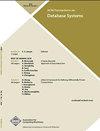A Join-Like Operator to Combine Data Cubes and Answer Queries from Multiple Data Cubes
IF 2.2
2区 计算机科学
Q3 COMPUTER SCIENCE, INFORMATION SYSTEMS
引用次数: 3
Abstract
In order to answer a “joint” query from multiple data cubes, Pourabass and Shoshani [2007] distinguish the data cube on the measure of interest (called the “primary” data cube) from the other data cubes (called “proxy” data cubes) that are used to involve the dimensions (in the query) not in the primary data cube. They demonstrate in study cases that, if the measures of the primary and proxy data cubes are correlated, then the answer to a joint query is an accurate estimate of its true value. Needless to say, for two or more proxy data cubes, the result depends upon the way the primary and proxy data cubes are combined together; however, for certain combination schemes Pourabass and Shoshani provide a sufficient condition, that they call proxy noncommonality, for the invariance of the result. In this article, we introduce: (1) a merge operator combining the contents of a primary data cube with the contents of a proxy data cube, (2) merge expressions for general combination schemes, and (3) an equivalence relation between merge expressions having the same pattern. Then, we prove that proxy noncommonality characterizes patterns for which every two merge expressions are equivalent. Moreover, we provide an efficient procedure for answering joint queries in the special case of perfect merge expressions. Finally, we show that our results apply to data cubes in which measures are obtained from unaggregated data using the aggregate functions SUM, COUNT, MAX, and MIN, and a lot more.一个类似join的操作符,用于组合数据集和回答来自多个数据集的查询
为了回答来自多个数据立方体的“联合”查询,Pourabass和Shoshani[2007]区分了感兴趣度量的数据立方体(称为“主”数据立方体)和其他数据立方体(称为“代理”数据立方体),这些数据立方体用于涉及(在查询中)不在主数据立方体中的维度。它们在研究案例中证明,如果主数据集和代理数据集的度量是相关的,那么联合查询的答案就是对其真实值的准确估计。不用说,对于两个或多个代理数据集,结果取决于主数据集和代理数据集组合在一起的方式;然而,对于某些组合方案,Pourabass和Shoshani为结果的不变性提供了一个充分条件,他们称之为代理非通用性。在本文中,我们将介绍:(1)将主数据多维数据集的内容与代理数据多维数据集的内容组合在一起的合并运算符,(2)通用组合方案的合并表达式,以及(3)具有相同模式的合并表达式之间的等价关系。然后,我们证明了每两个合并表达式等价的模式的代理非共性特征。此外,我们还提供了在完全合并表达式的特殊情况下回答联合查询的有效过程。最后,我们展示了我们的结果适用于数据立方,其中度量是使用聚合函数SUM、COUNT、MAX和MIN等从非聚合数据中获得的。
本文章由计算机程序翻译,如有差异,请以英文原文为准。
求助全文
约1分钟内获得全文
求助全文
来源期刊

ACM Transactions on Database Systems
工程技术-计算机:软件工程
CiteScore
5.60
自引率
0.00%
发文量
15
审稿时长
>12 weeks
期刊介绍:
Heavily used in both academic and corporate R&D settings, ACM Transactions on Database Systems (TODS) is a key publication for computer scientists working in data abstraction, data modeling, and designing data management systems. Topics include storage and retrieval, transaction management, distributed and federated databases, semantics of data, intelligent databases, and operations and algorithms relating to these areas. In this rapidly changing field, TODS provides insights into the thoughts of the best minds in database R&D.
 求助内容:
求助内容: 应助结果提醒方式:
应助结果提醒方式:


